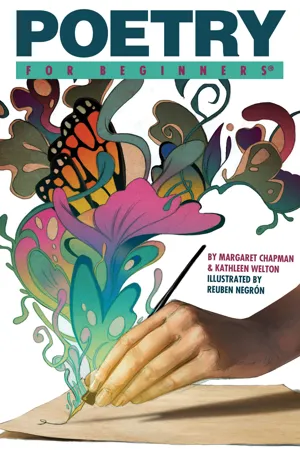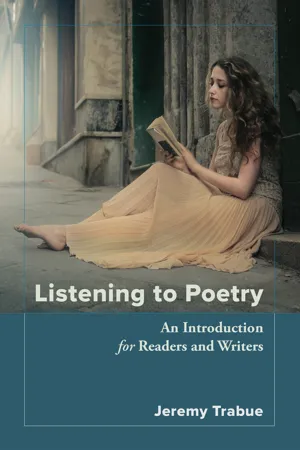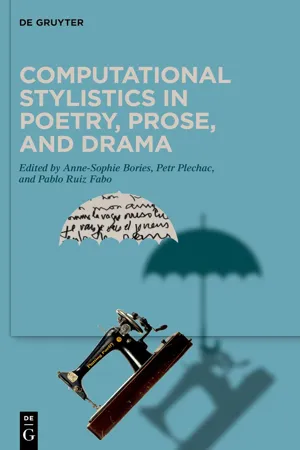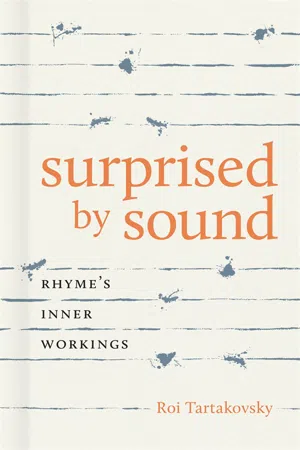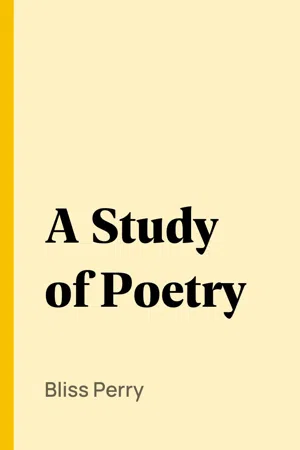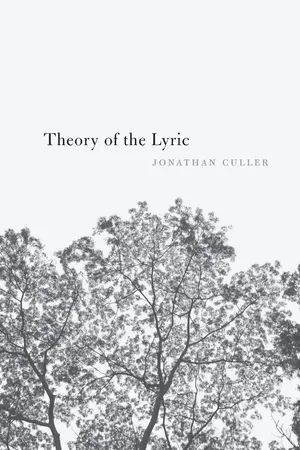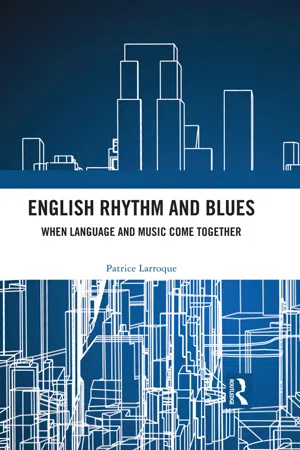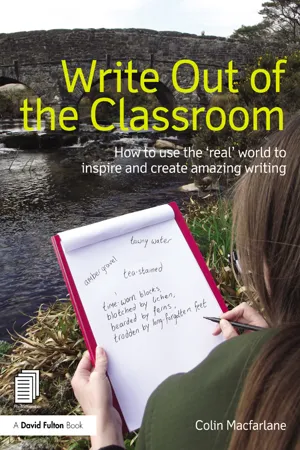Languages & Linguistics
End Rhyme
End rhyme refers to the rhyming of the final words of lines in a poem or song. It is a common poetic device used to create rhythm and musicality in the text. End rhyme is often denoted by letters to indicate the pattern, such as AABB or ABAB.
Written by Perlego with AI-assistance
9 Key excerpts on "End Rhyme"
Learn about this page
Index pages curate the most relevant extracts from our library of academic textbooks. They’ve been created using an in-house natural language model (NLM), each adding context and meaning to key research topics.
- eBook - ePub
- Margaret Chapman, Kathleen Welton, Reuben Negrón(Authors)
- 2010(Publication Date)
- For Beginners(Publisher)
Every poem basically exists two ways—it exists on the page, and it exists read out loud. Some poems do better one way or another—concrete poetry and experimental poetry sometimes can't be read out loud. Other types of poems, especially poems that use rhyme and rhythm, or play with the sound of language, might seem better when they are heard than when they are read.Many people think of rhyme when they first think of poetry.The simple definition of rhyme is when two or more words have the same ending sound. Rhymes sometimes have the same written ending, but because English spelling is all over the place, often words rhyme even if they look completely different.For example: Ease Breeze Orange Blorenge (a place in Wales) Rhyme is a little more complicated than just the same ending sound - there are two sorts of rhyme. Perfect rhymes also have to have the same pattern of stress on the syllables. For example: Beautiful DutifulAnother common type of rhyme in poetry is slant rhyme. Slant rhyme is when words sound similar, but don't actually rhyme. Slant rhyme actually encompasses a few different literary techniques, including half rhyme, when the final consonant sounds match, consonance, when most of the consonant sounds match, assonance, when just the vowel sounds match, and sometimes even alliteration - eBook - ePub
Listening to Poetry
An Introduction for Readers and Writers
- Jeremy Trabue(Author)
- 2019(Publication Date)
- Chemeketa Press(Publisher)
At the other extreme, there are also many people who think of nonrhyming poetry as “modern” and rhyming poetry as “traditional.” This is also inaccurate. Old English poetry did not rhyme at all, nor did much poetry in Middle English. Unrhymed verse has been part of modern English right from the beginning. Seventeenth-century poet John Milton wrote a blistering attack on rhyme in his introduction to Paradise Lost (which does not rhyme). And most early English dramatic verse is mostly written without any rhyme (though some short rhyming passages do appear in Shakespeare and other renaissance drama).The role and importance of rhyme in poetry was much debated and contested in Milton’s time, and it still is today. Unrhymed poetry is more common, but rhyming poetry is alive and well. Rhyme is not omnipotent or omnipresent. Rhyme does not define “poem.” However, it is a part of poetry, and it’s here to stay.Rhyme is one of those subjects for which the phrase “deceptively simple” was created. Most preschoolers recognize and can give examples of rhyming words. Most could easily recognize the rhymes in this list:bed / embed / said / read bay / weigh / astray / they wing / asking / unifying / testifying lady / bee / abbey / tabbyBut what exactly makes these words “rhyming”? The entire ending syllable is not exactly the same in each one because the ending syllables may start with different consonant sounds. The spelling is certainly not the same in each one. However, the ending syllable after its initial con sonant sound is the same. Notice that they don’t have to have the same number of syllables, either, as long as that final syllable sound after its initial consonant is identical.Rhyme is the repetition of the same vowel sound followed by the same consonant sound—if there is one—in the final syllable of two or more words and in close enough proximity that it creates an obvious pattern. That’s the basic definition, but there is a lot of variation just under the surface of that definition that you should be aware of.Varieties of Rhyme
Rhyme is such a rich subject that there are different varieties of rhyme.First, rhymes can be either internal or end. End Rhyme occurs at the ends of lines, and is the most common.When people talk about rhyme, they usually mean End Rhyme. Internal rhyme, - eBook - ePub
The Princeton Encyclopedia of Poetry and Poetics
Fourth Edition
- Stephen Cushman, Clare Cavanagh, Jahan Ramazani, Paul Rouzer, Stephen Cushman, Clare Cavanagh, Jahan Ramazani, Paul Rouzer(Authors)
- 2012(Publication Date)
- Princeton University Press(Publisher)
But again, it is essential to bear in mind that, even for rhyme types directly appropriated from the Romance langs. and for which the Eng. terms are simply direct trans., the effect is not the same: rhyme is a markedly different phenomenon in inflectional langs., where identity of word ending is pervasive and often must be actually avoided, than in positional langs., where inflectional endings are almost entirely absent and where sound similarity is more dependent on the historical evolution of the lexicon. Notwithstanding, this difference does not automatically make the Romance langs. rhyme “rich” and the Germanic langs. rhyme “poor,” as has often been thought: it is not merely the quantity of like endings that is at issue.D. Analogues .Inside poetry, there are a number of structures that have rhyme-like effects or functions or exceed the domain of rhyme, verging into repetition. The *sestina, e.g., repeats a sequence of whole words rather than rhyme sounds. Several rhetorical devices generate comparable effects to those of rhyme even in unrhymed verse: in the 10,000 lines of Paradise Lost , there are over 100 cases of epistrophe, nearly 100 of *anaphora, 60 of *anadiplosis, 50 of *epanalepsis, and 40 of epizeuxis, all of them, as Broadbent says, “iterative schemes tending to the effect of rhyme.” Milton also weights words at line end (Broadbent calls this “anti-rhyme”), counterposing semantically heavy and contrastive terms at Paradise Lost 4.561–62, e.g.: “Tempt not the Lord thy God, he said and stood. / But Satan smitten with amazement fell”—an effect reinforced all the more by reiteration of these two terms via *ploce ten more times in the following 21 lines, and echoed thereafter at 4.590–91 (cf. 9.832–33). In *American Sign Language poetry, poets achieve rhyme-like effects using hand shapes.Outside poetry, rhyme is commonly thought of as a “poetical” device, but, in fact, it is a broadly attested ling. structure used for marking the ends of important words and phrases to make them memorable. Rhyme is widely used not only for ludic and didactic purposes, as in rhymed and rhythmical calendrical mnemonics, children’s counting-out and jump-rope rhymes, and jingles for ads (see Chasar) but for other types of memorable speech such as *proverbs, *epigrams, inscriptions, mottoes, *riddles, puns, and jokes (Brogan). Children seem to be able to manufacture rhymes not only spontaneously and happily but more readily than the other six forms cited at the top of section II.B above, suggesting that the closural or “final-fixed” structure that is rhyme is somehow more salient for cognitive processing (see Rayman and Zaidel), as the vast lit. on the role of rhyme in promoting children’s phonemic awareness, lang. acquisition, and literacy suggests. Perhaps the most common form of rhyming in lang. is seen in mnemonic formulas, catch phrases that rhyme, e.g., true blue , ill will , fender bender , double trouble , high and dry . The list of such popular and proverbial phrases is astonishingly long, and the device is also used in poetry (Donne, “Song (Go and Catch a Falling Star”); Eliot, Four Quartets ; see CLOSE RHYME - Anne-Sophie Bories, Petr Plecháč, Pablo Ruiz Fabo, Anne-Sophie Bories, Petr Plecháč, Pablo Ruiz Fabo(Authors)
- 2022(Publication Date)
- De Gruyter(Publisher)
Although poetry is made up of words arranged in sentences, the conventions of meter, line length, and rhyme sometimes require the alteration of natural syntax. Conventions of poetic discourse or register also constrain which words or kinds of expression are considered acceptable in poetry at a given historical moment. Individual poets necessarily write within and against such conventions, following or modifying them to suit their expressive needs. These conventions also contribute to the “horizon of expectations” that readers bring to their evaluation of poetic texts (Jauss, 1982 : 19). Before the twentieth century, most lyric verse in English was written using line-End Rhyme (McDonald, 2012). (Dramatic and narrative verse, in contrast, was frequently written in unrhymed iambic pentameter lines.) Because English is less inflected than many European languages and because of the long-standing preference for one-syllable rhymes in English, the number of possible rhyme pairs is fairly limited. In order to account for the effects of rhyme, analysis of word frequencies in poetry should include analysis of the frequency and distribution of line-end words as distinguished from words found elsewhere in the text. 1.2 Rhyme In English poetry, rhyme is predominantly used in the final word of the poetic line. Two syllables that rhyme “have identical stressed vowels and subsequent phonemes but differ in initial consonant(s) if any are present” (Brogan, Cushman, 2012 : 1184). Although the majority of rhymes commonly used in English poetry are masculine rhymes of only one syllable, feminine two-syllable rhymes may also be used occasionally. In the nineteenth century, many critics preferred exact rhymes (hat/cat) over near rhymes (hat/fact) or eye rhymes (love/prove), which are visible on the page but not heard in pronunciation. Rhyme creates relationships of similarity and difference among the line-end words in a poem- eBook - ePub
Surprised by Sound
Rhyme's Inner Workings
- Roi Tartakovsky(Author)
- 2021(Publication Date)
- LSU Press(Publisher)
1 Hearing and Listening to Rhyme If negotiating with linguistic constraints and literary conventions comes with the territory of writing poetry, rhyme occupies a great part of that territory. Certainly, in the case of English, it is difficult to overstate the association between rhyme and poetry, or the significance of rhyme to poetry. This association is attested to in rhetoric by rhyme’s synecdochic or metonymic substitution for poetry itself. Rhyme-as-poem is a prevalent trope throughout much English-language poetry and is nowhere more evident than in William Shakespeare’s ending of Sonnet 17: “You should live twice, in it and in my rhyme.” In practice, rhyme’s prevalence is attested to by the overwhelming number of rhymed poems written by generations of poets. Of course, rhyme is not the only sound device, nor the earliest in the history of English poetry. A perfect or full rhyme is, in fact, one of numerous poetic sound devices, including assonance, alliteration, consonance, and many forms of partial rhymes. But it is the more encompassing member among most of these weaker or partial sound relations because full rhyme typically requires a correspondence of both the vowel and the following consonant sounds of the last stressed syllable of each word. 1 Assonance was never used systematically in English verse, partial rhyme is best appreciated as a subset of full rhyme, and alliteration, while carrying its own historical connotations of Anglo-Saxon prosody, seems, at least in poetic consciousness, more distant and dimmed today than rhyme. 2 Rhyme, both historically and phonetically, is set up to stand out in the soundscape of the poem or of poetry. As prevalent as rhyme is (or was —a question I will get to momentarily), it is easy to forget that rhyme’s entry into English poetry was a gradual process and one that—in spite of scholarly interest—remains somewhat murky. Murkier yet is the larger question of the historical origin of rhyme itself - eBook - ePub
- Bliss Perry(Author)
- 2005(Publication Date)
- Perlego(Publisher)
Rhyme is thus a form, an "externalizing" of rhythm. It is structural as well as decorative, or rather, it is one way of securing structure, of building verse. There are other devices, of course, for attaining symmetrical patterns, for conveying an impression of unity in variety. The "parallel" structure of Hebrew poetry, where one idea and phrase is balanced against another, "I have slain a man to my wounding— And a young man to my hurt—" or the "envelope" structure of many of the Psalms, where the initial phrase or idea is repeated at the close, after the insertion of illustrative matter, thus securing a pattern by the "return" of the main idea—the closing of the "curve"—may serve to illustrate the universality of the principle of balance and contrast and repetition in the architecture of verse. For Hebrew poetry, like the poetry of many primitive peoples, utilized the natural pleasure which the ear takes in listening for and perceiving again an already uttered sound. Rhyme is a gratification of expectation, like the repetition of a chord in music [Footnote: "Most musical compositions are written in quite obvious rhymes; and the array of familiar and classical works that have not only rhymes but distinct stanzaic arrangements exactly like those of poetry is worth remembering. Mendelssohn's 'Spring Song' and Rubinstein's 'Romance in E Flat' will occur at once as examples in which the stanzas are unmistakable." C. E. Russell, "Swinburne and Music," North American Review, November, 1907.] or of colors in a rug. It assists the mind in grasping the sense-rhythm,— the design of the piece as a whole - eBook - ePub
- Jonathan Culler(Author)
- 2015(Publication Date)
- Harvard University Press(Publisher)
Contrasting the rhyming practice of Chaucer and other poets, who are not attempting witty, semantically productive rhymes, with that called for by Pope, James Wimsatt distinguishes two systems of sound in poetry: in the symbolic system, phonemes and intonation patterns carry meaning through differential organization of the sound plane, but in the prosodic system, which includes line division, syllable count, stress, rhyme, and refrain, sounds produce what “may be called music, not for employing a harmonic or melodic organization of tones but for its mathematical organization of phonetic units, sometimes marked by stress and rhyme.” There may be local semantic effects but its main effect is iconic rather than semantic: it is self-reflexive and nonsymbolic, signifying the instantiation of poetry but not directly related to verbal meaning. Describing the increasing and subsiding density of rhymes in John Skelton’s two- and three-beat lines, Susan Stewart notes that the insistent rhymes of “Mistress Margaret Hussey” “effect the turns and metamorphoses of praise by something akin to uttering spells”:Merry Margaret, As midsummer flower, Gentle as falcon Or hawk of the tower With solace and gladness, Much mirth and no madness …Rhyme is “always a showcase for the arbitrary nature of the sign and limits our efforts to dominate meaning; rhyming draws us beyond ourselves with its potential for aural pleasure.”73Rhymes mark out lines and stanzas, contributing in a major way to rhythm (rhyme and rhythm both come from rhythmus), and they work to signify, iconically, the poetic event. Hegel identifies an erotic, teasing dimension to rhyme: in the different stanza forms of lyric, “it is as if the rhymes now find one another immediately, now fly from one another and yet look for one another, with the result that in this way the ear’s attentive expectation is now satisfied without more ado, now teased, deceived, or kept in suspense owing to the longer delay between rhymes, but always contented again by the regular ordering and return of the same sounds.” Mallarmé treats this structure as magical: “one cannot deny the similarity between the circle perpetually opening and closing with rhymes and the circles in the grass left by a fairy or magician.”74Whether we call it magic or not, one effect is to lend authority to lyric pronouncements. It is no accident that so many proverbs rhyme: “A stitch in time saves nine,” not eight or ten. The rap artist Jay-Z notes that rhyming allows hip-hop to contain contradictions and “make sense of the world in a way regular speech can’t.” He contrasts his spoken introduction to a song, which offers the beginning of an argument (“You can agree or disagree”) with a line from the song itself:I’d rather die enormous than live dormant / that’s how we on it.“That’s it. No argument. It is what it is. Why? The rhyme convinces you. The words connect. That simple couplet takes the idea of the spoken intro and makes it feel powerful, almost unassailable. Think about it: O. J. Simpson might be a free man today because ‘glove don’t fit’ rhymed with ‘acquit.’ It was a great sound bite for the media, but it was also as persuasive as the hook on a hit song. That’s the power of rhymes.”75 - eBook - ePub
English Rhythm and Blues
Where Language and Music Come Together
- Patrice Paul Larroque(Author)
- 2021(Publication Date)
- Routledge(Publisher)
The present discussion will first be an attempt to circumscribe what the notion of rhythm represents, its beats, tempo, and (especially African) influences. In this first part, the ideal eurhythmic structure of English is dealt with; it is, however, a structure which may present infractions. A second part is devoted to compensatory measures which aim at repairing these violations and thus restore the natural rhythm of English speech.2.2 RhythmThe word “rhythm” comes from Latin rhythmus, derived from Ancient Greek ρυθμός (rhuthmos, from the verb ρεϊν, “rhein,” flow) and it means two things which at first blush appear to be distinct, but are nonetheless closely related. On the one hand, it refers to a poetic form, a repetition of similar sounds in the final syllables of lines of a poem and, on the other hand, to the metric movement, to the progression, to the flow, and to the repeated occurrence of similar features or elements. These two definitions have regularity in common; the former is phonic since it organizes the sounds in the final positions of lines, and the latter is linked to harmony in that it is based on both a fluid movement (cf. the etymology of the word “rhythm”) and the regular occurrence of strong and weak beats. Thus, rhyme and rhythm contribute, at their respective level, to conveying a musical movement to the sentence.2.2.1 The notion of rhythmThe notion of rhythm supposes the repeated succession of elements, at regular intervals in time and space. We may speak of the rhythm of the seasons, the rhythm of the tides, the rhythm of the heart, or the rhythm of a piece of music. It is also called cadence when referring to poetry or a rhythmic flow of sounds in language. As Hasty (1997 : 3) summarizes, “among the attributes of rhythm we might include continuity of flow, articulation, regularity, proportion, repetition, pattern, alluring form or shape, expressive gesture, animation and motion (or at least the semblance of motion).” In his type of motion, the regularity of the succession is expected to continue (Abercrombie 1967 : 96). The result of these interactions between all these properties is that rhythm is a complex notion which combines esthetics with language dynamics and variation. Olivier Messiaen (1994–1996 - eBook - ePub
Write Out of the Classroom
How to use the 'real' world to inspire and create amazing writing
- Colin Macfarlane(Author)
- 2013(Publication Date)
- Routledge(Publisher)
It seems that the roots of complex words have evolved with more weight on them as they carry most of their meaning or descriptiveness. Less interesting bits of language, such as articles, connectives, pronouns and endings, are generally likely to be unstressed as they are, largely, part of the mortar of grammar rather than being the actual bricks of core description and meaning.How does all this link together?
We might ask why English poetry developed like this. I believe stressed beats act like tiny spotlights continuously illuminating important words or parts of words. Sound echoes make them stand out even more and add to the magical musicality of the rhythmic patterning. In effect, listeners are continuously ‘tapped on the shoulder’ by the stressed beats at each significant little part so they don't drift off or lose track. This was especially important in the oral societies of the past where poetry developed and where people were all listeners.I referred to rhythm as ‘magical’ because it also helps us relax and set aside our primitive ‘alert guard’ mode, enabling us to be absorbed into the ‘dream world’ of the poem.Poetry's sound patterning has always helped its creators and performers too. People can remember the gist of a story well enough to tell it, although rarely perfectly or in the same word order. A special quality of poetry is that, after gaining familiarity with a piece, one can remember it well enough to recite it from beginning to end, word for word. Its rhythm and sound echoes carry the performer along the lines while stressed beats continuously flag up new meanings, imagery and approaching words. At the completion of each line any end-rhyming used also helps alert the mind to what is coming next.Poetic meter
More ways in which meaning, description and rhythm are linked in poetry will become clear when we discover what basic building blocks of rhythmic patterns are possible.Traditionally, regular rhythmic patterns in English poetry are referred to as ‘meter’. This is made up of units known as ‘feet’, which come in different types, nearly all of which contain one stressed beat and at least one unstressed one. The sound patterns they create work alongside effects caused by having specific numbers of ‘feet’ per line, or sometimes patterns in which the numbers of feet differ in equivalent lines in each stanza.
